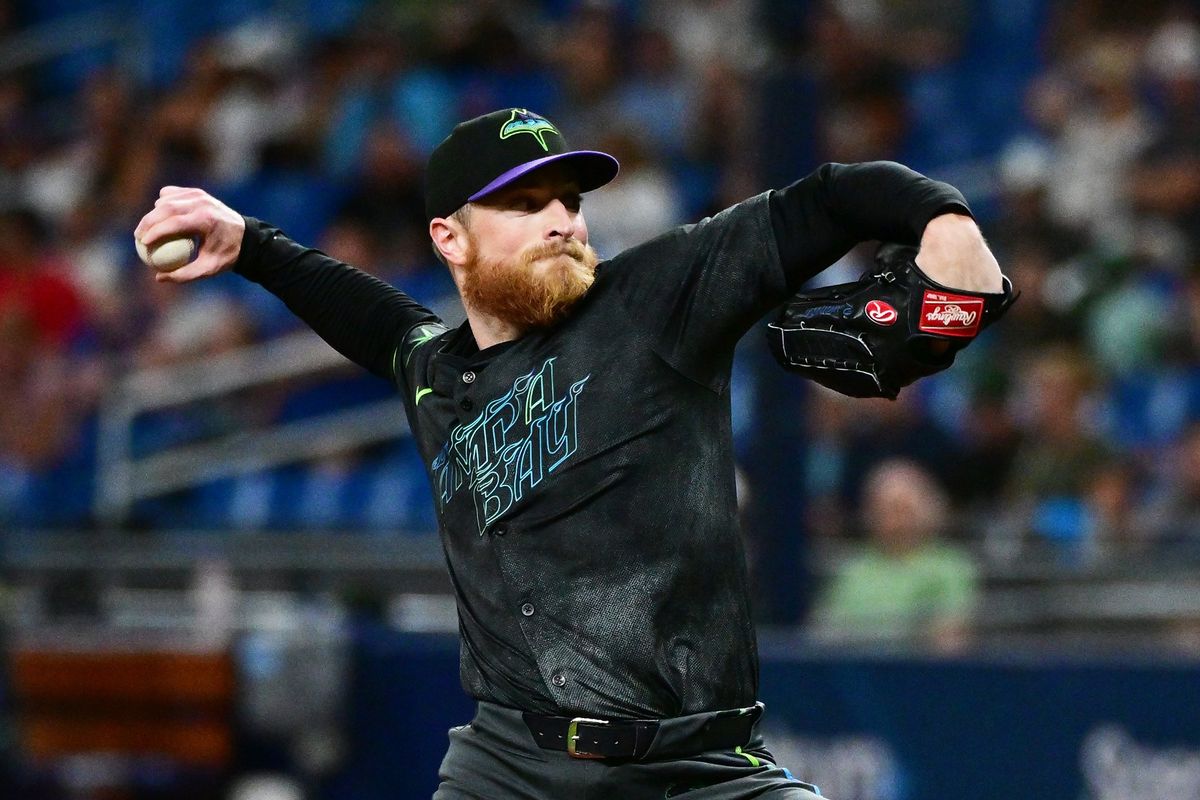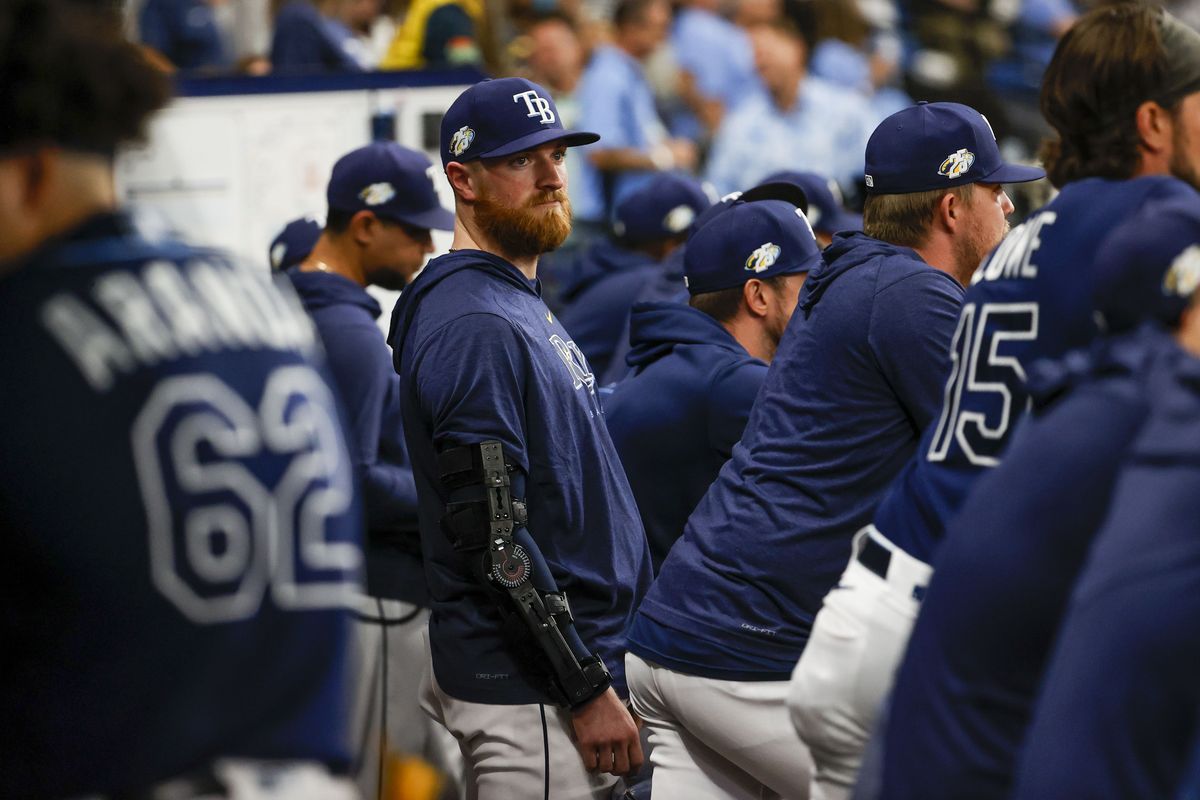‘He wasn’t going to give up’: Inside Mt. Spokane graduate Drew Rasmussen’s return to Rays from 3rd elbow surgery
Since returning from his third elbow surgery, former Mt. Spokane star Drew Rasmussen has appeared in two games this season for Tampa Bay, including Saturday’s start against Baltimore at Tropicana Field in St. Petersburg, Florida. (Tribune News Service)
ST. PETERSBURG – Understandably, there were some unsettling and uncertain days last summer as Tampa Bay Rays right-hander Drew Rasmussen dealt with the reality of needing a third major surgery on his pitching elbow in seven years.
“There’s not that many guys that have had three elbow surgeries that are pitching in the big leagues, so I think that that fear might have got to him a little bit,” Rasmussen’s wife, Stevie said. “Because you go to the doctor and they’re like, ‘We’re going to try, but we don’t have a set answer for you.’ ”
But once the July 2023 surgery, which included repair of Rasmussen’s flexor tendon (but not a third Tommy John procedure) and installation of an internal brace, was complete, there was no doubt Rasmussen – a 2014 graduate of Mt. Spokane High School – would do everything possible in the yearlong rehab to return to the major-league mound.
“Once he put his head down to rehab, that’s where the mental strength comes in,” Stevie said last week from Seattle. “He was going to do whatever he could. So, it was going to be that way until someone told him absolutely not. And, thankfully, we never got to that point.
“He just kept pushing along. It would take someone saying, ‘You don’t have a job anymore’ for him to give up. He wasn’t going to give up.”
When Rasmussen, 29, made a successful return a week ago in St. Louis, retiring all six batters he faced and clocking 98.7 mph, he said there were lots of people who deserved to be thanked.
The list started with Stevie – “This is her third elbow surgery as well” – for her constant and unwavering support, the daily inspiration she and their nearly 2-year-old son, Rhett, provide and the welcome respite from the mundane grind of rehab with the frequent family activities she planned. “Just waking up, seeing her, seeing him, it’s just a different level of motivation,” he said.
Rasmussen’s father, Mark, a longtime middle school history/social studies teacher and multisports coach in north Spokane, established the family’s intensive family work ethic. Butt-busting teammates set a tone along the way Rasmussen felt challenged to keep up with.
Rays staffers – coaching, athletic training, rehab and beyond – did the hands-on work, while bosses provided assurances they were invested in and committed to Rasmussen’s successful return.
Sports psychologist Brian Cain, who Rasmussen started working with after the May 2023 injury, “has been incredible for me,” the pitcher said, especially in understanding what is and isn’t in his control. Members of his extended family and others who share his strong religious faith also played a part in helping Rasmussen cope with and conquer his most difficult challenge.
“I’ve got a great support system,” he said. “God’s put so many good people in my life that are always there to support me. Being able to lean on people when you need them, I think that’s kind of the easy answer. But it’s also the obvious and truest answer.”
Ultimately, Rasmussen deserves the most praise.
First, for the extensive physical work he put in, with comparisons flowing to teammate Yandy Diaz, ex-Ray Nathan Eovaldi and others in what Rays manager Kevin Cash calls an all-time “elite” intensity of effort.
“We always joke on Drew that his shirt’s always drenched, but he’s not getting drenched watching TV and eating a sandwich,” infielder Brandon Lowe said. “There’s a reason why he’s drenched, why he’s always sweating – because he’s always working his ass off.”
Rays pitching coach Kyle Snyder said Rasmussen showed great mental strength in handling his latest cruel setback.
“I don’t know that there’s more than a handful of people out there in this game right now that could have put their head down and put their nose to the grindstone and said, ‘Look, I’m not going to just accept these medial elbow reconstructions as the end of my career,’ ” said Snyder, whose own pitching career was cut short by injuries.
“I felt different (Wednesday) in the two innings he threw than maybe at any other point in time in my career as a pitching coach. Some of that is what I’ve gone through and the nature of understanding the disappointment. But also just the willingness to say, ‘I’m not done yet.’ … I had a hard time not getting a little emotional.”
Current and former teammates were similarly awed.
“The work ethic that he puts into it and his diligence that he does in his personal care to get back on the field, I don’t think anyone questioned what he would be when he comes back,” said reliever Shawn Armstrong, who the Rays traded to the Cardinals on July 30. “For Drew to do what he’s done, I’m super happy for him. And everyone that’s watching the game or knows Drew should be happy, too.”
Said Andrew Kittredge, a former Ferris High School standout and an ex-Rays teammate now with the Cardinals, “I hope that he gets what he deserves, which is success and health, because he’s kind of had a rough go on that end. It’s always iffy when guys have multiple arm injuries and are trying to come back from that, but if anybody’s going to do it it’s going to be him. With his attitude and determination, I wouldn’t be surprised if he goes on to have a very long career.”
Rasmussen underwent his first Tommy John surgery in March 2016 as a sophomore at Oregon State. He came back throwing well and was drafted with the 31st overall pick by the Rays in June 2017, but they declined to sign him, apparently due to health concerns. He underwent a second Tommy John surgery in August 2017.
He came back from those dual crushing blows, was a sixth-round pick by the Brewers in 2018, got to the majors in August 2020, was traded to – of all teams – the Rays in May 2021 (with reliever J.P. Feyereisen in the deal for shortstop Willy Adames) and pitched pretty well for a while with no arm issues.
The May 11, 2023, start at Yankee Stadium was one of his best, seven shutout innings with two hits and seven strikeouts, which made the severity of the injury more surprising – and frustrating.
Rasmussen said his elbow “started barking a little bit” facing his final batter, and an initial MRI “showed something that we didn’t want to see.” A follow-up MRI a few weeks later confirmed the flexor tendon injury, plus a “partial” tear of the ulnar collateral ligament, which often leads to Tommy John surgery.
Only two pitchers have made it back to the majors after a third Tommy John procedure: Jason Isringhausen and Jonny Venters (with the Rays). Dr. Keith Meister, who did Rasmussen’s second Tommy John surgery, had a different, less traumatic idea this time.
“Drew just was worried in the beginning that he was going to be able to get his elbow repaired to make it what it could be,” Stevie said. “And Dr. Meister is some sort of genius.”
Once the physical issue was addressed, Rasmussen was going to make sure the mental aspect was taken care of. Stevie saw his amazing positivity during his second Tommy John rehab, which included missing Oregon State’s 2018 national championship run, and was confident he’d handle the third rehab just as well.
“He’s never going to feel sorry for himself,” she said. “He’s not going to throw the pity party.”
How, given all the reasons for negativity and cynicism, could he be that way yet again?
“It’s not like there’s one answer to tell you,” Stevie said. “It’s just that he’s the best human ever. I’m not just saying that because he’s my husband. He just is.”

